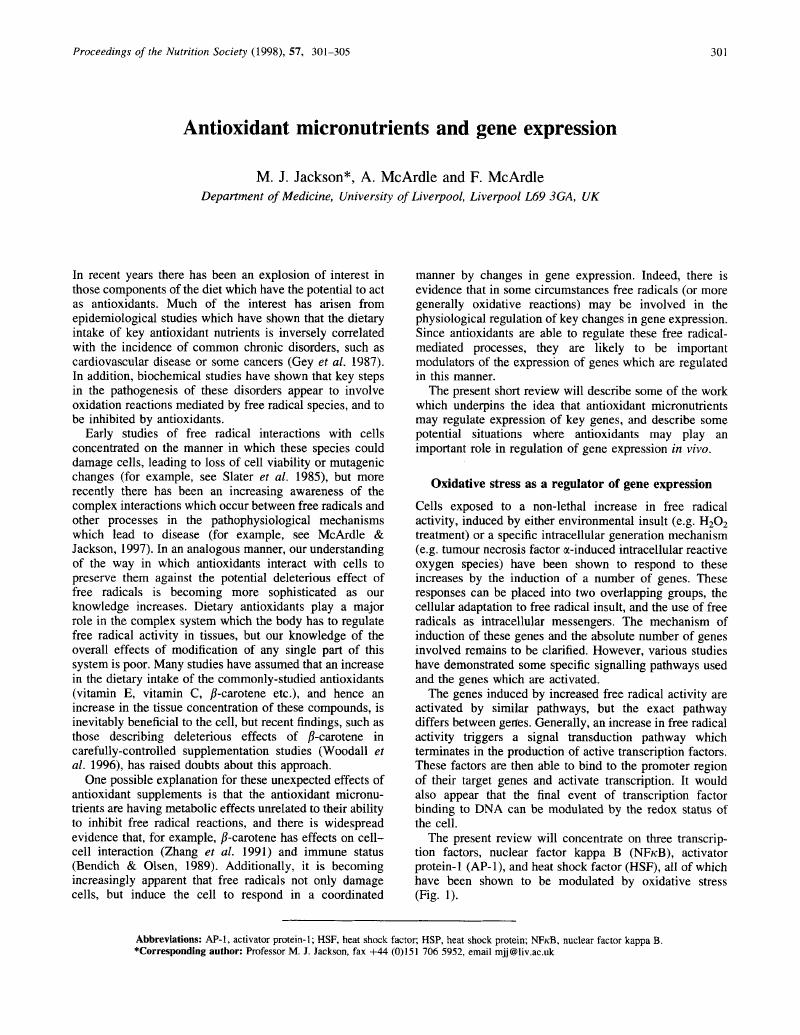Crossref Citations
This article has been cited by the following publications. This list is generated based on data provided by Crossref.
Pawelec, Graham
1998.
Anti-Aging Medicine Literature Watch.
Journal of Anti-Aging Medicine,
Vol. 1,
Issue. 4,
p.
375.
Jackson, Malcom J.
1999.
Free radicals in skin and muscle: damaging agents or signals for adaptation?.
Proceedings of the Nutrition Society,
Vol. 58,
Issue. 3,
p.
673.
Hughes, David A.
1999.
Effects of dietary antioxidants on the immune function of middle-aged adults.
Proceedings of the Nutrition Society,
Vol. 58,
Issue. 1,
p.
79.
Benzie, Iris F. F.
1999.
Vitamin C: prospective functional markers for defining optimal nutritional status.
Proceedings of the Nutrition Society,
Vol. 58,
Issue. 2,
p.
469.
Hughes, David A.
1999.
Effects of carotenoids on human immune function.
Proceedings of the Nutrition Society,
Vol. 58,
Issue. 3,
p.
713.
Jones, S.A.
McArdle, F.
Jack, C.I.A.
and
Jackson, M.J.
1999.
Effect of antioxidant supplementation on the adaptive response of human skin fibroblasts to UV-induced oxidative stress.
Redox Report,
Vol. 4,
Issue. 6,
p.
291.
Hughes, David A.
2000.
Dietary antioxidants and human immune function.
Nutrition Bulletin,
Vol. 25,
Issue. 1,
p.
35.
Jackson, Malcolm J.
2000.
Handbook of Oxidants and Antioxidants in Exercise.
p.
57.
Virgili, Fabio
Pagana, George
Bourne, Louise
Rimbach, Gerald
Natella, Fausta
Rice-Evans, Catherine
and
Packer, Lester
2000.
Ferulic acid excretion as a marker of consumption of a French maritime pine (Pinus maritima) bark extract.
Free Radical Biology and Medicine,
Vol. 28,
Issue. 8,
p.
1249.
Hughes, David A.
Wright, Anthony J. A.
Finglas, Paul M.
Polley, Abigael C. J.
Bailey, Angela L.
Astley, Sian B.
and
Southon, Susan
2000.
Effects of Lycopene and Lutein Supplementation on the Expression of Functionally Associated Surface Molecules on Blood Monocytes from Healthy Male Nonsmokers.
The Journal of Infectious Diseases,
Vol. 182,
Issue. s1,
p.
S11.
Rimbach, Gerald
Gohil, Kishorchandra
Matsugo, Seiichi
Moini, Hadi
Virgili, Claude Saliou, Fabio
and
Weber Packer, Stefan U. , Lester
2001.
Induction of glutathione synthesis in human keratinocytes by Ginkgo biloba extract (EGb761).
BioFactors,
Vol. 15,
Issue. 1,
p.
39.
Khassaf, Muna
Child, Robert B.
McArdle, Anne
Brodie, David A.
Esanu, Cristian
and
Jackson, Malcolm J.
2001.
Time course of responses of human skeletal muscle to oxidative stress induced by nondamaging exercise.
Journal of Applied Physiology,
Vol. 90,
Issue. 3,
p.
1031.
Orsi, Nicolas M.
and
Leese, Henry J.
2001.
Protection against reactive oxygen species during mouse preimplantation embryo development: Role of EDTA, oxygen tension, catalase, superoxide dismutase and pyruvate.
Molecular Reproduction and Development,
Vol. 59,
Issue. 1,
p.
44.
Dufresne, Christiane J.
and
Farnworth, Edward R.
2001.
A review of latest research findings on the health promotion properties of tea.
The Journal of Nutritional Biochemistry,
Vol. 12,
Issue. 7,
p.
404.
Grimble, R. F.
2001.
Nutritional modulation of immune function.
Proceedings of the Nutrition Society,
Vol. 60,
Issue. 3,
p.
389.
Sarada, S.K.S
Dipti, P
Anju, B
Pauline, T
Kain, A.K
Sairam, M
Sharma, S.K
Ilavazhagan, G
Kumar, Devendra
and
Selvamurthy, W
2002.
Antioxidant effect of beta-carotene on hypoxia induced oxidative stress in male albino rats.
Journal of Ethnopharmacology,
Vol. 79,
Issue. 2,
p.
149.
Rayssiguier, Y.
and
Mazur, A.
2002.
Trace Elements in Man and Animals 10.
p.
97.
McArdle, F
Rhodes, L.E
Parslew, R
Jack, C.I.A
Friedmann, P.S
and
Jackson, M.J
2002.
UVR-induced oxidative stress in human skin in vivo: effects of oral vitamin C supplementation.
Free Radical Biology and Medicine,
Vol. 33,
Issue. 10,
p.
1355.
Munday, Karen
2003.
Vitatmin C and bone markers: investigations in a Gambian population.
Proceedings of the Nutrition Society,
Vol. 62,
Issue. 2,
p.
429.
Broome, Caroline S.
Vasilaki, Aphrodite
and
McArdle, Anne
2003.
Aging of the Organs and Systems.
p.
73.





